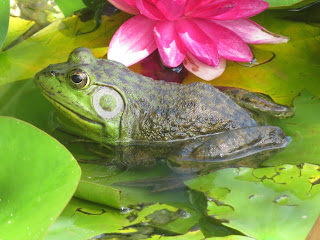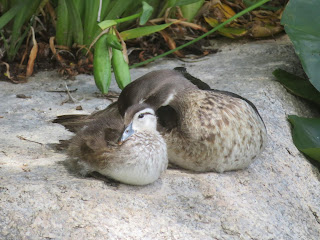The wet season is the most wonderful for seeing strange and unusual animals in Corrales. Even the common animals can become amazing. Even the landscape improves; with harsh sun giving way to soft cloudy light. Shadows disappear and all life takes on a calmer aspect.
The amphibians are coming out. This spadefoot is hard to photograph as they are only around at night (two weeks out of the year!). The harsh LED light gives a fuzzy look and heavy shadows when using a smartphone camera. But look at those staring, bronze eyes and "eyebrows". Pretty intense, because this amphibian has a lot on it's mind.
In the summer, the bullfrogs are so colorful, especially against this lily flower. The huge ear and skin fold around it is distinctly bullfrog. The huge head makes the eyes seem much smaller.While the large bullfrog tadpoles take 2 years to mature, this new, tiny spadefoot tadpole has to be out of the water before 2 weeks have finished, or it risks desiccation in the hot, dry desert air. This one already has the back legs forming. For these tadpoles, it pays to have parents that are prepared to travel as soon as there is the promise of moisture in the air, and lucky enough to be in the right place at the right time.
These red weevils are collecting in groups for mating purposes. After egg laying, they quickly disperse back into the fast growing weeds, or sunflowers in this case
This root borer beetle is extending her ovipositor to lay the eggs deep beneath the ground's surface. I wonder where this structure is able to be stored when not in use. It takes several minutes for her to fully extend it for useThe hide beetles are usually found in areas of the desert where something recently died and was scavenged. The hide beetles arrive to the feast when almost everything possible has been eaten.
There will be many more of these cicada killers in the summer. Right now the females are creating burrows to fill with cicadas to feed their grubs.
The flame skimmer is a pretty common dragonfly in the western US. The vivid orange body and wings is very striking drifting over the pond plants.
This dragonfly is a common whitetail. Over 99% of the aquatic nymphs die before reaching maturity, and then the sexually mature adults live for only 2 weeks.This large butterfly is a swallowtail. They are pretty common but can be devilish to photograph. This one was in the butterfly pavilion at the Biopark gardens.Click beetles are usually very dispersed and hidden. The grubs, called wireworms, are very destructive because they begin to feed just as the new seedlings are putting out roots. Most of those monsoon weeds will not survive to adulthood because of the combined activity of these grubs and decreasing moisture in the soilSmall mouth bass are introduced and have been around since the civil war, transported about the country by steam train in the early days to provide sport entertainment in the days before television. They are important predators of the larger wetland habitats.
Now that the water for Corrales irrigation is sourced from the Rio Grande river directly via diesel pumps, there will be many changes to the ditch ecosystem. This catfish is swimming downstream in very shallow water. A slippery, soft skin, strong dorsally flattened tail, and bony head help push it forward against all the odds. These fish have amazing luck, and an ability to thrive and reproduce.Many birds have fledgling babies right now. While the mortality is still very high, paternal care push the odds in favor of survival. For ducks, the attentive mom is always close by to give an early warming of unrecognized danger.
Hummingbirds are lightening fast and unpredictable. They defend their nests against any and all interlopers, no matter the size. These birds are often why heavily treed areas near to water sources don't have even higher bird diversities.
This structure has me a little confused. It appears to be a gall on New Mexico Olive, but the biology information on this is pretty sparse. Galls are just the way certain organisms make their eggs; by using a host plant species to provide the building material for them by clever manipulation of plant growth hormones. Due to the wet soil, the chances are this is a fungal or bacterial species doing this. Maybe it's crown gall disease, but I don't know. It is more common when the temperatures are lower in the summer, which they have been this year.Human made trails in the rain create particular problems, especially in the tropics, where soils are easily affected. But even in our bosque, the constant trampling of human feet produce these artificial puddles. They quickly become breeding ponds for mosquito and midges. Also, the mud puddles force humans in tennis shoes to walk around them, widening and damaging the surrounding soil and vegetation
Many areas of compacted soil actually benefits certain beetle grub species. An impermeable surface prevents water infiltration. This not only prevents the grubs from asphyxiating but also forces the tree roots to stay shallow. I have been told by urban foresters that tree roots rely on water evaporation just under the surfaces of roads and buildings in built up areas. This is partly the reason why we have weeds collecting along the edges of roads and in cracks in the asphalt. These holes in the picture are not from people's walking sticks, but are emergence holes, likely from cicadas. The new toadlets often use these to hide in during the day, and during dry periods.
Toads and ants actually have an antagonistic relationship, with young toads staying near standing water which ants cannot traverse to avoid being attacked. Ant burrowing activities dry out the topsoil with aeration. This prevents the colony becoming water logged, or their seed store germinating. The drier soil affects which plants will grow, favoring invasive shrubs with deep roots over native grasses.
This hole has been enlarged by something with feet. It could have been a lizard, but more like a toadlet looking for a place to hide. Holes and burrows are very important to creatures and are often enlarged rather than created from scratch, so to speak.
Ants, especially harvester ants, are much better gardeners than we give them credit for. The grainy appearance of this soil is because the mud is carried out, jawful by jawful from below the surface. Forager specialized ants drop cottonwood and elm seeds at the entrance for the nest maintenance ants to evaluate and bring back down into the nest. If they are interrupted by a couple of days rain, many of these seeds will begin to sprout and are then ignored by the ants. Cottonwood seeds, elms, amaranth, grass, or birdseed are all collected avidly when they are in season.
The soil has an interesting ability to regulate germination. Conditions appear to be ripe for a growth of morning glory seedlings. Confusingly, bindweed and morning glories are not the same plant, but often called the same thing and sort of closely relatedSlime molds are a whole different animal, literally. This is the dog vomit slime mold. A slime mold is it's own animal, not a fungus, plant or animal. This collective group of cells often found where there is a lot of watering on bark mulch. Officially, it is an acellular ameboid. This is one of the weirder organisms in a world of weird critters.























No comments:
Post a Comment